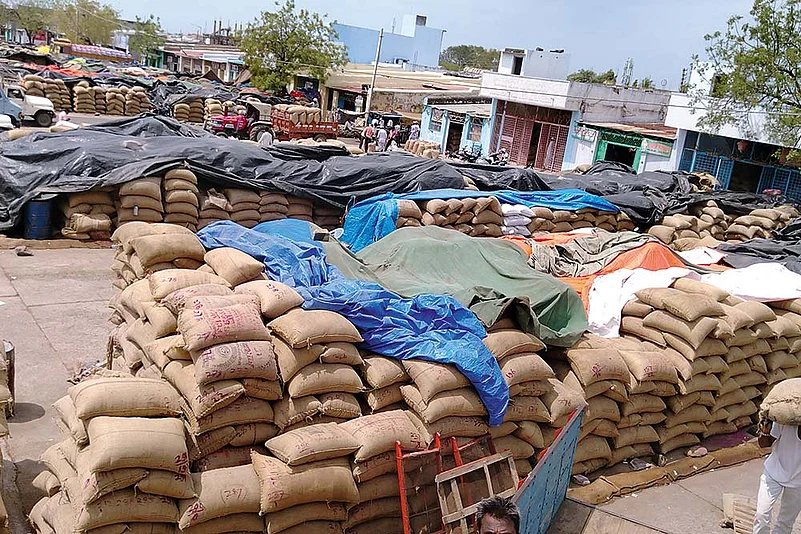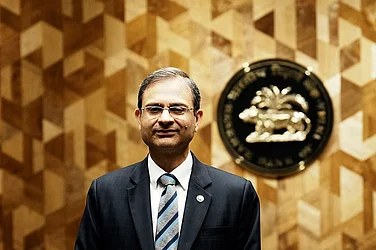Hard Pressed
- A record 22.1 million tonnes output is likely, 34% more than 16.4 million tonnes in 2015-16
- To curb sharp rise in prices, the government is creating a buffer stock of 2 million tonnes
- 3.78 lakh tonnes imported and 9.91 lakh tonnes procured from farmers so far
- Farmers are getting much less than prices fixed by the government
- Farmers demand higher buffer-stock target and curbs on imports
***
In India, a bumper crop is not always an occasion to celebrate, as farmers have often found to their cost whether it is potato, onion or grapes. Pulses, which have always been far short of domestic needs, are facing a similar fate this year, with mandi prices in many parts of the country far below the minimum support price (MSP) for different varieties. In some cases, the farmers are not even getting enough to recover their cost of production, even as retail prices remain on the higher side.
Good rainfall last year, after two consecutive years of deficit rainfall, is expected to boost production to a record 22.1 million tonnes from a low of 16.4 million tonnes in 2015-16. While the kharif output is pegged at 8.7 million tonnes as against 5.5 million tonnes in the previous year, the rabi output is expected to be 13.4 million tonnes, up from 10.8 million tonnes. The jump in production is not just due to better rains, but also because of pulses being cultivated over more land and the use of better seeds, driven by the high prices last year when retail prices of tur or arhar (pigeon pea), for instance, crossed Rs 200 per kg in some markets.
To prevent a repeat overheated price scenario, last year an expert committee chaired by the finance ministry라이브 바카라 chief economic advisor Arvind Subramanian had suggested the creation of a buffer stock of 2 million tonnes, besides higher MSP and bonus to encourage more cultivation by farmers.
The lure of a higher MSP and expectations of high market prices did work, but a large number of farmers in states such as Karnataka, Maharashtra, Madhya Pradesh, Rajasthan and Uttar Pradesh are finding few takers now for their stocks at the promised price, forcing many to hold on in the hope that the government would rethink plans to import more for meeting the buffer stock target. The state governments and the industry lobby India Pulses and Grain Association (IPGA) have approached the central government to raise the buffer stock target through domestic procurement, raise import duty and also allow for exports to ensure that farmers do not suffer.
Food and consumer ministry data reveals that state agencies had imported 3.78 lakh tonnes of pulses by March 14, out of the 4.01 lakh tonnes contracted so far, while 9.91 lakh tonnes out of a target of 1 million tonnes had been procured from mandis across the country by March 11.
Wherever the government procurement process is on, it has helped farmers get remunerative prices for kharif pulses. But, given the volumes, the procurement has been slow for various reasons, including shortfall of jute bags, according to reports from Karnataka.
Maruti Manpade, central committee member of the CPI(M)-affiliated All India Kisan Sabha, says the price of tur or arhar is currently just Rs 4,000 per quintal, far below the government-fixed MSP of Rs 5,050 plus Rs 450 bonus being provided by the Karnataka government, as well as last year라이브 바카라 high of Rs 10,000-12,000.
“Purchasing by central government agencies is not being done properly, so the mill owners are paying a lot less than the government-fixed price not just in Gulburga, but also in other mandis in the state,” says Manpade, who is also president of the Karnataka Pranta Raita Sangha. Recently, shortage of jute bags resulted in no transactions taking place in Gulbarga APMC yard for 15 days, resulting in a stockpile of pulses. Gulbarga accounts for 60 per cent of pulses production in Karnataka.
Farmer leaders are upset that while the central government is importing from countries such as Mozambique, not much is being done to ensure that domestic farmers are paid the promised returns—50 per cent more than production cost. The largest consumer and importer of pulses, India has been depending on imports of 5-6 million tonnes to bridge its growing demand for pulses, which is the major source of protein in most households. The per capita consumption of pulses per day was just 47.2 grams in 2014 in a country where pulses are part of daily consumption in some form or the other.
Compared to last year, domestic prices have dipped over 50 per cent in most mandis, points out IPGA vice-chairman Bimal Kothari. For instance, tur price has dipped from Rs 95 per kg to Rs 40, while moong has dipped from Rs 80 to Rs 45, black channa from Rs 110 to Rs 47, lentils (masoor) from Rs. 60 to Rs 38. In fact, most unprocessed pulses are selling at almost 15-20 per cent below their respective MSPs.
“Though government agencies started buying on time, they could not match the pace of mandi arrivals,” says Kothari. “That is why prices are dipping below MSP. Farmers keen to sell are being forced to do so below the MSP.”
Suresh Jaat of Samaj Pragati Sahyog, an NGO based in Madhya Pradesh, says most farmers who shifted from soyabean cultivation to other pulses lured by high price expectations, particularly in remote villages, are disappointed with the prevailing prices. “The situation is bad as most pulses are selling below the MSP,” says Jaat. “For instance, tur is selling at around Rs 3,500-4,000 per quintal as against the MSP of Rs 5,050, while masoor is selling for Rs 4,500-5,000 as against the MSP of Rs 5,250 and freshly harvested channa is not fetching any premium over the MSP of Rs 4,000. Small farmers are more affected as they have a maximum of 15 quintals and, being in no position to go to the mandi themselves, they are forced to sell to local traders at much lower prices.”
Bhagwan Singh, who has cultivated urad and channa in his 15-acre farm in Jalawar near Kota in Rajasthan, says he has not sold his urad stock “in the hope of getting a better price”, while the channa crop is still to be harvested. Last year, Singh sold tur for Rs 10,300 per quintal. “Prices have fallen sharply this year due to either too much production or too much import by the government,” says Singh, whose 11-member family depends solely on the farm income. “Selling at the current prices means losses for us. We would not even recover our costs as we had used the best seeds that cost Rs 400 per kg.”
Singh is part of Uday Santra Kisan Produce Co, an FPO (farmer producer organisation) with 1,000 members, of whom nearly 250 are holding on to their stocks, expecting prices to rise. Similarly, Arpit Jain of Ram Rahim FPO in Bagli block of Madhya Pradesh라이브 바카라 Devas district, says that while significant quantities of tur have been sold to government agencies at Rs 5,050 per quintal, the delay in payments has led many farmers to sell in the open market for as low as Rs 3,500-3,800. In some cases, quality issues have also contributed to farmers’ inability to sell to government agencies, which have been using the services of FPOs this year. Lack of processing and handling infrastructure remains a challenge in some areas.
Given India라이브 바카라 import dependence to bridge production shortfalls, Kothari says the government should raise the buffer stock procurement target to 5 million tonnes, or at least double it, particularly given the forecast of a weak monsoon this year due to the El Nino effect. Moreover, it is important to address the concern that if the farmers don’t get proper prices this year, next year may see a dip in the area under pulses cultivation.














